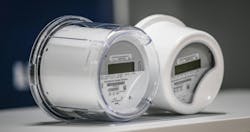When you work inside a substation, many problems will sneak in without your knowledge and some of them may be catastrophic. As utility professionals know, a catastrophic substation failure can bring a lot of attention — the kind you don't want.
Unfortunately, no silver-bullet solutions are available to prevent substation failure. These failures can be caused by a variety of factors, including power transformers, batteries, breakers or protection schemes that fail or weren't set correctly. But one of the most common issues revolves around problems with disconnect switches and bus connections.
These types of problems can take down substations and inflict major damage. In addition, they can require switching plans to be halted because switches won't open, won't close, are raining down sparks when asked to carry load or are flashing over when asked to interrupt load.
Scanning with Infrared
When evaluating the state of utility substations, switches and connections should top the list. In-house crews can perform switch maintenance with just a little training. And, once the switches and connections are operating properly, this will eliminate one large opportunity for a catastrophic failure and also make all future switching go smoothly and predictably.
Infrared scanning helps technicians spot problems. It's beneficial to conduct infrared scanning of all substations and some transmission lines every year. Also, when possible, it's best to schedule the work in times of heavier loads.
When doing the infrared scanning, it's important to note that infrared is crucial but not perfect. For example, infrared is not effective for switches that sit open normally or for switches feeding “out of service” loads on the day you scan. Wires may still burn down even though they passed an infrared scan, even if they were carrying load during the scan.
If a connection does fail shortly after passing an infrared scan, a utility could be looking at a connection failure cycle. In this situation, the connection can get so hot carrying load that it will melt and then weld together. This weld makes a good connection, at least for the amount of current at the time, and the infrared scan of the weld may show nothing. Then, at a later date, the current is raised beyond the capabilities of the weld area and the wire burns in two.
Making Preparations
To successfully guard against untimely outages, substation technicians should not rely on infrared technology alone. Instead, they should also consider adding resistance-based tests in the substation. These tests also can be applied to transmission and distribution switches or selected line connections. Resistance-based testing involves using a micro-ohm meter, which measures tiny amounts of resistance (such as what would be the resistance of a few feet of bus). After this test is applied to all switches and connections in a station, the tester can be sure the tested items will not heat up under rated loads because every switch is included, even the ones that are normally open.
To begin, you'll need some basic tools and maintenance parts for this testing. First, and most important, you'll need a good micro-ohm meter such as the Megger DLRO200-115. This is a meter that puts out 200 A of filtered DC current. The advantage of filtered DC current is that you can avoid a false trip. If you have a differential scheme and the relays are still connected to the current transformer (CT) of the device you are testing, you can run this filtered DC through the CT and the DC will not be sensed in the differential circuit.
In addition, you should have upgraded bolts for the connection pads and bimetal pads in all three sizes (two-hole, 3-inch four-hole, and 4-inch four-hole). The reason for the bimetal pads is that sometimes when connections fail, it's due to someone improperly making them up, putting copper against aluminum. These can be redone installing the bimetal pads between the dissimilar metals. It's a good idea to upgrade the bolt system for the connections. Normally, it's only necessary to change the bolts if a connection fails the micro-ohm test.
The preferred connection system for bolted pad type connections consists of a stainless steel bolt (long enough so at least two threads protrude through the nut), two stainless-steel ³/16-inch-thick flat washers, one on each side of the connection, one 3,500-lb stainless-steel Belleville washer on the nut side and a silicon bronze nut. The bolts are ½ inch and should be tightened to a torque of 45 ft-lb. This will compress the 3,500-lb Belleville washer to about 60% compression, which will mean the connection can expand and contract with heating and cooling cycles and not stretch the bolt. And the connection will maintain constant tension through the years.
The last trick is to clean up the mating surfaces with Scotch Bright or whatever cleaner is needed to get them clean. Then coat the surfaces with an oxidation inhibitor like DE-OX, a non-gritted “green” inhibitor from Ilsco. There's no reason to use a gritted inhibitor because the parts are de-energized and can be completely cleaned. If the Scotch Bright can't get the old dried inhibitor off, try a scraper. As a general rule, you should avoid sanding or filing because, if the terminals are tin-plated, you could go through the tin very easily.
Testing the Equipment
After cleaning and preparing the surfaces, it's time to test with a micrometer. Technicians should put the clamp around the entire switch assembly, including all connections associated with the switch. It's important to clean the bus to bare metal for this connection using a wire brush and some light sanding.
When talking about micro-ohms, you cannot have any resistance. It's often effective to run the maximum current of 200 A, provided the components are rated for it. It's important that at least one side of the switch — or whatever part you are testing — is not grounded.
One way to do it is to take a reading on the entire assembly, and then if it passes, you are done. The values you get will vary with switch quality and materials, but a typical 1,200-A copper switch (along with the switch pads at both ends and the bus to terminal connections at both ends) might be in the 350 micro-ohm range. It doesn't take long to develop a feel for what to expect. You must look for things that stand out. If you're testing a different kind of switch and you're not sure what to expect, if all three poles match, chances are, you are in good shape. If one or two poles stand out, you probably should work on the higher poles to see if you can get them to match the lower poles.
If you run into a problem pole using this connection across everything, then leave the 200-A current connections across the whole switch but move your voltage leads across the individual connections. For example, you can measure the resistance of just one end of the switch contacts, the bolted pads, the clamp to the bus or the hinged end of the switch. This will allow you to isolate your problem quickly so you know what needs attention. All of this is done by just moving along with the voltage probes, and the 200-A current source stays connected across the entire switch.
Checking Equipment
The moving through all the switches with the micro-ohm meter should be done in conjunction with switch maintenance. The contacts should be cleaned, being careful to not scratch through the silver plating on the contacts. You must check for proper alignment of poles and contacts, and pay particular attention to the condition of the contacts in regards to pitting or loss of silver. Make sure you have good contact pressure and then apply a thin coat of Dow Corning 1292 white grease. One benefit of this grease is that it will stay soft, so when you are back in three to five years for routine maintenance, it will wipe off with a rag.
If the switch happens to be a load break type, it's important to test the interrupter. Load break switches work by making a parallel between the switch contacts and the interrupter unit as the switch is starting to open. Normally, most switch manufacturers don't want any current in the interrupter unit when the switch is closed. If this is the case, test for the proper clearances or the interrupter can burn up under normal load.
As the switch opens, load current is paralleled between the main contacts and the interrupter. This parallel has to be maintained as you continue to open the switch until a sufficient gap exists between the main contacts to avoid re-strike as the load is interrupted. The interruption will occur either using a vacuum bottle or an expulsion-type snuffer device. In either case, you'll need to test that the closed interrupter has low resistance. In most cases, anything less than an ohm can be used for a go/no-go.
After you have proven you can pass current through the closed interrupter, the next step is to prove the interrupter can interrupt the current at full voltage. If the interrupter is of the snuffer type, there's no real test you can do. If the interrupter is of the vacuum type, verify with the manufacturer that the vacuum bottle can be tested with a hi-pot. Applying voltage to the open vacuum bottle is the only way to prove the vacuum exists and the interrupter will interrupt load at line voltage.
If all these procedures are followed on all connections and switches in the station during a three- to five-year cycle, you should have eliminated at least one looming source for serious catastrophic substation problems.
Gary Wright ([email protected]) consults for McMinnville Water & Light and Forest Grove Light & Power in Oregon. He started out in the power industry in 1977, and recently worked for Clark Public Utilities in charge of substations, metering and relaying, and is now retired.
Insider Tips for Maintenance
Gary Wright, who has been responsible for the maintenance of more than 100 substations over the last 35 years, shares his tips from the field.
Infrared: Often some of the transmission lines can be scanned as you drive to each station. It's usually beneficial to hire an infrared contractor to scan transmission lines and the most important distribution feeders.
Nuts: It's important to use a silicon bronze for the nut, because if you use a stainless-steel nut, the nut can gall and stick. This means you can't get the connection tight. Unfortunately, it will appear tight, and you might not be able to get the nut back off.
Grounding: There can only be one ground connected anywhere on the conductor you are testing. If there is a second ground installed anywhere, it will become a parallel current path and make your reading useless.
Companies mentioned:
Dow Corning | www.dowcorning.com
Ilsco | www.ilsco.com
Megger | www.megger.com

